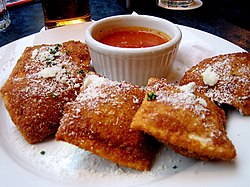Origin
Most accounts of toasted ravioli trace its origins to a predominantly Italian-American neighborhood of St. Louis, The Hill. Supposedly, in the early 1940s, a ravioli was accidentally dropped into the fryer by a chef. Shortly thereafter, the item began appearing on menus across The Hill. While many restaurants on The Hill claim its creation, [4] Charlie Gitto's "On The Hill" restaurant (then known as "Angelo's") is where it was made famous. That story claims that a chef at Angelo's, Mario Battocletti, accidentally dropped the pasta into oil after a misunderstanding. Chef and restaurateur Charlie Gitto, Jr. inherited the original recipe and still serves it at his restaurants to this day.
Another claim is from Mama Campisi's as well as Louis Oldani. [5] Oldani is said to have named the dish 'toasted' ravioli because he thought 'toasted' was more appealing than 'fried'. [6]
Lombardo's Restaurants, located around the St. Louis area, also claim to have been among the first to bring toasted ravioli to the States from Sicily; their current owner, Tony Lombardo, shows menus from the 1930s that include it. [7] Lombardo's toasted ravioli frequently tops lists as the "best t-ravs in St. Louis". [8]
This page is based on this
Wikipedia article Text is available under the
CC BY-SA 4.0 license; additional terms may apply.
Images, videos and audio are available under their respective licenses.
